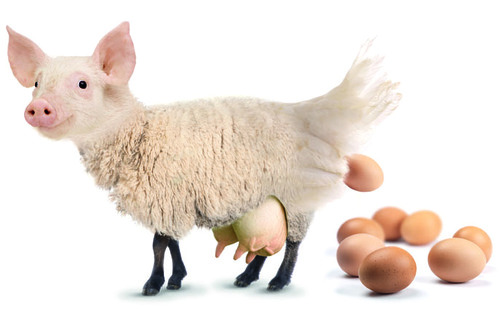Eierlegende Wollmilchsau
In the last books I read for my DMin program, I came across concepts of leadership and parameters to measure and interpret responses of members to certain leadership actions or problematical situations.
It is interesting, that in Jim Collins book „Good to great. Why some companies make the leap and others don’t“ aswell as in Albert O. Hirschmann’s “Exit, Voice and Loyality. Responses to Decline in Firms, Organizations and States” communication and interaction played an important role in leadership.
This week I read “The leadership mystique. Leading behavior in the human enterprise” by Manfred Kets de Vries. When I started reading it, it reminded me in the first chapters of the last to books I mentioned. The next chapter reminded me of of Margaret J. Wheatley’s „Leadership and the new science. Discovering order in a chaotic world“ we already read in the cohort. And so it went.
Manfred Kets de Vries deals with so many differnt topics and issues in this book, that it always reminds me of other literature we already engaged in the cohort. But despite the exhausting variety, de Vries never suffocats the reader. This is done by a smart mix of theory and praxis, input and self-reflection. De Vries offers self-test questionnaires that turn the analyze of personal and organizational leadership issues into a fun survey.
I like the way he connects immanent conditions of a leader in the interaction with others. Only if this decoding step is understood, this tool can be transferred to other settings. De Vries for example uses this for intercultural transfers or the leaders adaption in other plural contexts.
It is one of the most inspiring books, we read so far in our cohort. Kets de Vries offers in his book a wide leadership concept that starts with the leader itself and connects it with the people the leader interacts with and the understanding of organizations. This is why de Vries lays the foundational ground in explaining the “human mystique” already in the very first chapter.
In the following chapters he provides a variety of different approaches like understanding and using emotional intelligence, decoding reflexive refusals to change and transition, rational and irrational forces as well as narcissism, gaining of resources, neurotic styles of leaders and their organizations and positive characteristics of effective leadership, change in global and intercultural settings, charismatic and architectural leadership, succession, development, authentizotic organizations… just to name a few.

The concept of division is the most enriching part to me. By dividing and deconstructing the different qualities and charism’s of a leader into separated steps, de Vries offers an understanding of leadership potentials as tools. This set of skills is multifunctional and helps to adapt flexible to particular leadership settings.
The expectation of an all-rounder in only doable and achievable if the leader understands himself/herself and the organizational settings he/she engages and interacts in. In German we have a sarcastic characterization of all-rounders in leadership called: “Eier legende Wollmilchsau.” (Egg-laying woolmilkpig).
A completely multi-equipped and broadly talented leader is an utopia and wishful thinking. But the only way we can get close to this, is by dealing with the different layers step by step and one at a time. For this endeavor De Vries submits a perfect leadership concept and personal self-reflections. It is no book to be ever finished with. – Or as Manfred Kets de Vries closes in his 12th. chapter by quoting John F. Kennedy
“Leadership and learning are indispensable to each other.”
Leave a Reply
You must be logged in to post a comment.